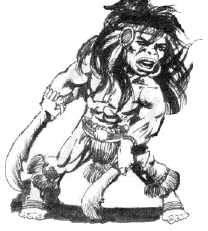|
|

- Wild Halflings live in tribal groups in secluded forest areas.
They are territorial to extremes, most trespassers end up on their
dinner table. However, once friendship of a Wild Halfling is gained,
the Wild Halfling will be fanatically loyal to that friend, even
sacrificing his own life for that of his friend. Because of the
value of friendship in the Wild Halfling culture, they seldom
make friends outside of their tribe.
|
|
|
|
|
 |
|
|
Wild halfling
|
|
- Wild halflings tend to have long, dark colored hair, usually brown
or black, though blonde- and red-haired halflings are not unknown.
There skin is dark tan almost copper in color and they typically
have more body hair than other halfling subraces, however, they
are unable to grow facial hair. Eye color is most commonly green
or hazel, but amber, blue and violet eyes are also found among
this subrace. Their infravision extends to 60' range.
- Wild Halflings dress in animal skins and adorn their hair with
feathers and mud. They paint their faces with natural pigments
before battle and prepare themselves by consuming large quantities
of braydleberry wine, an extremely intoxicating beverage only
produced by Wild Halfling tribes.
- Only the Tallfellows are longer lived than the Wild Halflings.
The average Wild Halfling lives to an age of 150 years and some
tribal elders have been known to reach an age of 230 years. Young
halflings are initiated into the tribe soon after they reach adolescence,
usually on their 20th birthday, though practices vary from tribe
to tribe.
- Wild Halfling villages consist of tree house connected by rope
bridges and swaying wooden walkways. The ground beneath the treetops
is typically unmarred save for a communal fire pit and racks for
drying fish, tanning hides and smoking meat. Most tribes tend
to mark the borders of their territories with the bleached skulls
of their enemies posted on slender posts in a wide circle around
the lands they claim as their own. Those who cross beyond these
warning posts are considered fair game for halfling hunters —
whether sentient or not. Wild Halfling villages are often guarded
by giant badgers and other beasts of the forest that the halflings
have befriended — and by the tribe's warriors.
- Separate male and female tribal councils see after the defense
and provisioning of the village. A single chief, always male,
leads the tribe. Males members of the tribe are usually responsible
for defense and hunting and female members are usually responsible
for gathering foodstuffs, raising the children and doing the domestic
chores around the village. However, females dissatisfied with
the traditional role of the female in halfling society have been
known to leave the tribe to form Nog Circe, wise circles, of female
warriors.
- Wild Halflings are skilled hunters and work in groups to bring
down large prey. They favor spears, slings and blowguns equipped
with poison darts for hunting and receive a +1 bonus to hit with
all these weapons. They are also known to use pits and snares
to great affect in their hunting and in defense of their homes.
- In a woodland setting a small band of wild halflings are formidable
opponents. They use their ability to blend into natural surroundings
to ambush their prey and then overwhelm it with superior numbers.
- Wild Halflings are even more adept at stealthy movement than their
more civilized cousins and when alone or acting with other Wild
Halflings in natural surroundings their opponents' surprise rolls
are penalized by -5 or -3 if the halflings must pass through a
door or screen. If the Wild Halflings are not operating in natural
surroundings (a town or castle, for example) the penalty is reduced
to -2 or -1 if they must pass through a door or other portal.
- Wild Halflings have a natural ability with animals and prove to
be expert animal trainers. They are also quite skilled at tanning
and working the hides they obtain from animals. They are superior
fishermen and often quite skilled at canoeing. Rope Use and Fire-building
are also skills which are indispensable to a Wild Halfling and
these are taught to all young members of the tribe beginning at
an early age (both are received as bonus nonweapon skills). These
halflings are also taught from childhood how to identify the various
beneficial herbs of the forest, though only the tribal shaman
are experts in this field.
- Wild Halflings are by nature superstitious and somewhat fearful
of magic. Most carry a medicine bag bearing various charms, talismans
and other objects believed to ward off evil magic. An indirect
benefit of this practice is that all Wild Halflings receive Psychic
Defense as a bonus nonweapon skill.
- Woodland life and a close affinity with nature has given Wild
Halflings the ability to communicate with woodland animals (at
the cost of a language slot). They speak their own language which
is not understandable by other halflings. They may also learn
to speak the languages of orcs, goblins, and elves. Wild halfling
characters may not speak the Trade Tongue or Common Halfling when
created, however, both languages can be learned later in the character's
career.
|



